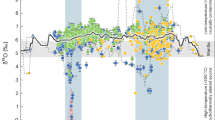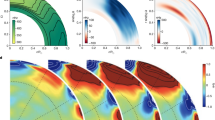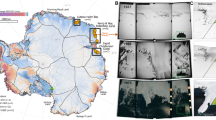Abstract
SPACE-BASED observations have established that the Sun's irradiance varies with solar magnetic activityl-4. A fraction of this variability arises from the increased area of cool gas associated with sunspots, which decreases irradiance; but on average the blocking effect of sunspots is more than offset by the increased emission from photospheric faculae and other effects of magnetic activity5 (although the precise contributions of these opposing effects remain poorly constrained6,7). Here we show that the apparent radius of the Sun, when viewed in the spectral line of neutral iron at 525 nm, also varies in phase with solar magnetic activity. This variation probably results from changes in the temperature profile of the Sun's atmosphere with the solar cycle. If similar behaviour is found for other spectral lines, changes in the apparent radius of the Sun could account for a significant fraction (~20%) of the total irradiance variations.
This is a preview of subscription content, access via your institution
Access options
Subscribe to this journal
Receive 51 print issues and online access
$199.00 per year
only $3.90 per issue
Buy this article
- Purchase on Springer Link
- Instant access to full article PDF
Prices may be subject to local taxes which are calculated during checkout
Similar content being viewed by others
References
Willson, R. C. & Hudson, H. S. Nature 351, 42–44 (1991).
Hoyt, D. V., Kyle, H. L., Hickey, J. R. & Maschoff, R. H. J. geophys. Res. 97, 51–63 (1992).
Fröhlich, C. in The Sun as a Variable Star Solar and Stellar Irradiance Variations (eds Pap, J. M., Fröhlich, C., Hudson, H. S. & Solanki, S. K.) 28–36 (Cambridge Univ. Press, 1994).
Willson, R. C. in The Sun as a Variable Star Solar and Stellar Irradiance Variations (eds Pap, J. M., Fröhlich, C., Hudson, H. S. & Solanki, S. K.) 54–62 (Cambridge Univ. Press, 1994).
Hudson, H. S. A. Rev. Astr. Astrophys. 26, 473–501 (1988).
Foukal, P. & Lean, J. Astrophys. J. 328, 347–357 (1988).
Foukal, P., Harvey, K. & Hill, F. Astrophys. J. 383, L89–L92 (1991).
LaBonte, B. A. & Howard, R. H. Science 214, 907–909 (1981).
Brown, T. M. in Solar Radiative Output (ed. Foukal, P.) 176–188 (Natn. Cent. for Atmos. Res., Boulder, CO, 1987).
Laclare, F. Astr. Astrophys. 125, 200–203 (1983).
Gavryusev, V., Gavryuseva, E., Delache, P. & Laclare, F. Astr. Astrophys. 286, 305–308 (1994).
Gilliland, R. L. Astrophys. J. 248, 1144–1155 (1981).
Delbouille, L., Roland, G. & Neven, L. Photometric Atlas of the Solar Spectrum from λ3000 to λ10000 (Institut d'Astrophysique de I'Univ. de Liège, Cointe-Ougreé, Belgium, 1973).
Neckel, H. & Labs, D. Sol. Phys. 90, 205–258 (1984).
Libbrecht, K. G. & Woddard, M. F. Nature 345, 779–780 (1990).
Pallé, P. L. in GONG'94: Helio- and Astero-Seismology from Earth and Space (eds Ulrich, R. K., Rhodes, E. J. Jr & Däppen, W.) 239–249 (Astr. Soc. Pacific, San Francisco, CA, 1995).
Author information
Authors and Affiliations
Rights and permissions
About this article
Cite this article
Ulrich, R., Bertello, L. Solar-cycle dependence of the Sun's apparent radius in the neutral iron spectral line at 525 nm. Nature 377, 214–215 (1995). https://doi.org/10.1038/377214a0
Received:
Accepted:
Issue Date:
DOI: https://doi.org/10.1038/377214a0
This article is cited by
-
Long-term Variations in the Intensity of Plages and Networks as Observed in Kodaikanal Ca-K Digitized Data
Solar Physics (2017)
-
Solar Radius at Subterahertz Frequencies and Its Relation to Solar Activity
Solar Physics (2017)
-
Solar Magnetoconvection and Small-Scale Dynamo
Space Science Reviews (2017)
-
A Comparison of the 10.7-cm Radio Flux Values and the International Sunspot Numbers for Solar Activity Cycles 19, 20, and 21
Solar Physics (2012)
-
Comparison of long-term trend of solar radius with sunspot activity and flare index
Astrophysics and Space Science (2011)
Comments
By submitting a comment you agree to abide by our Terms and Community Guidelines. If you find something abusive or that does not comply with our terms or guidelines please flag it as inappropriate.



